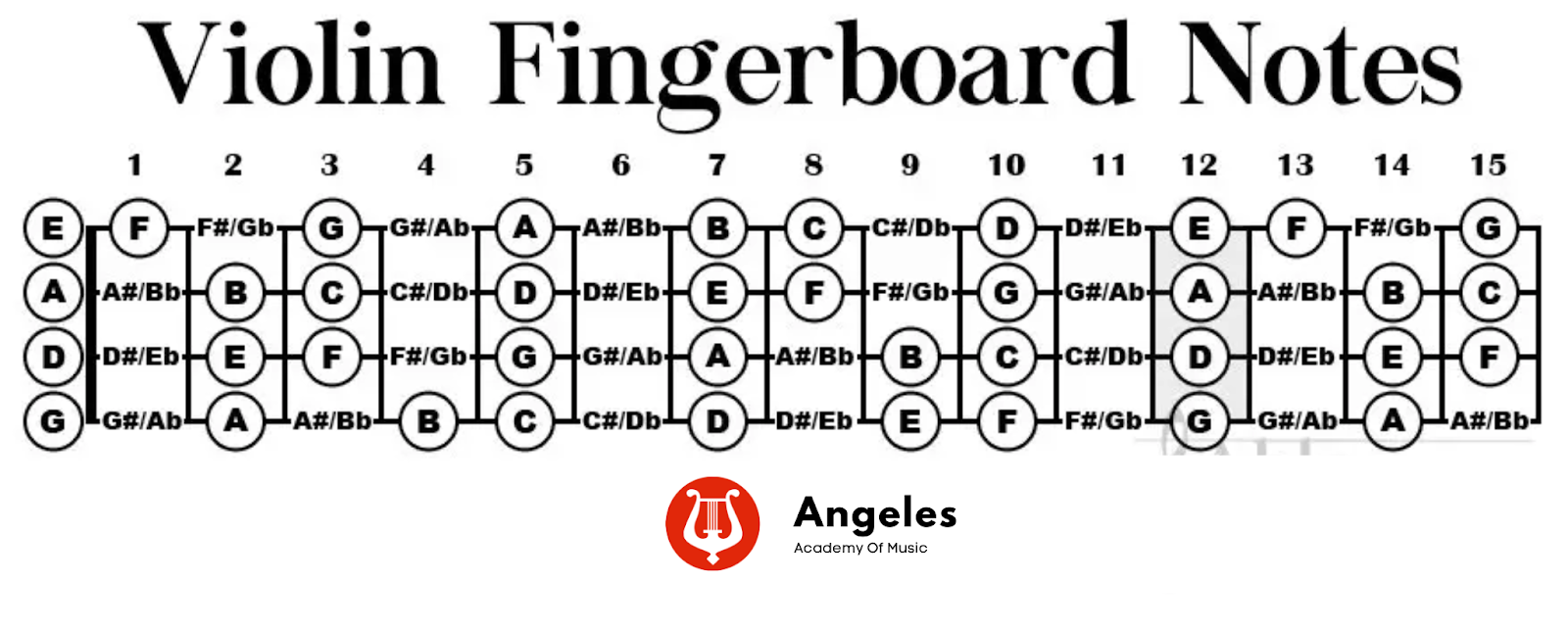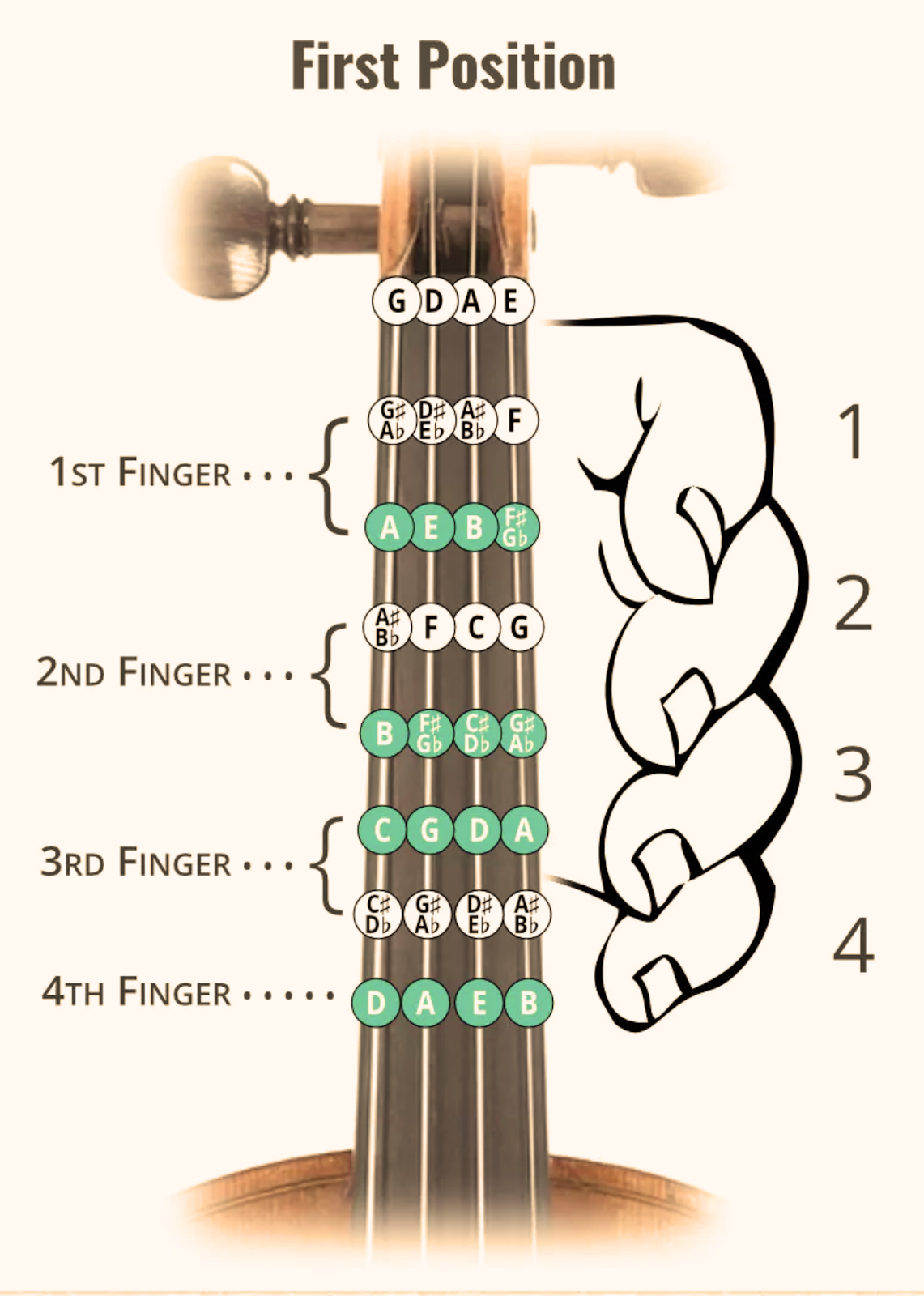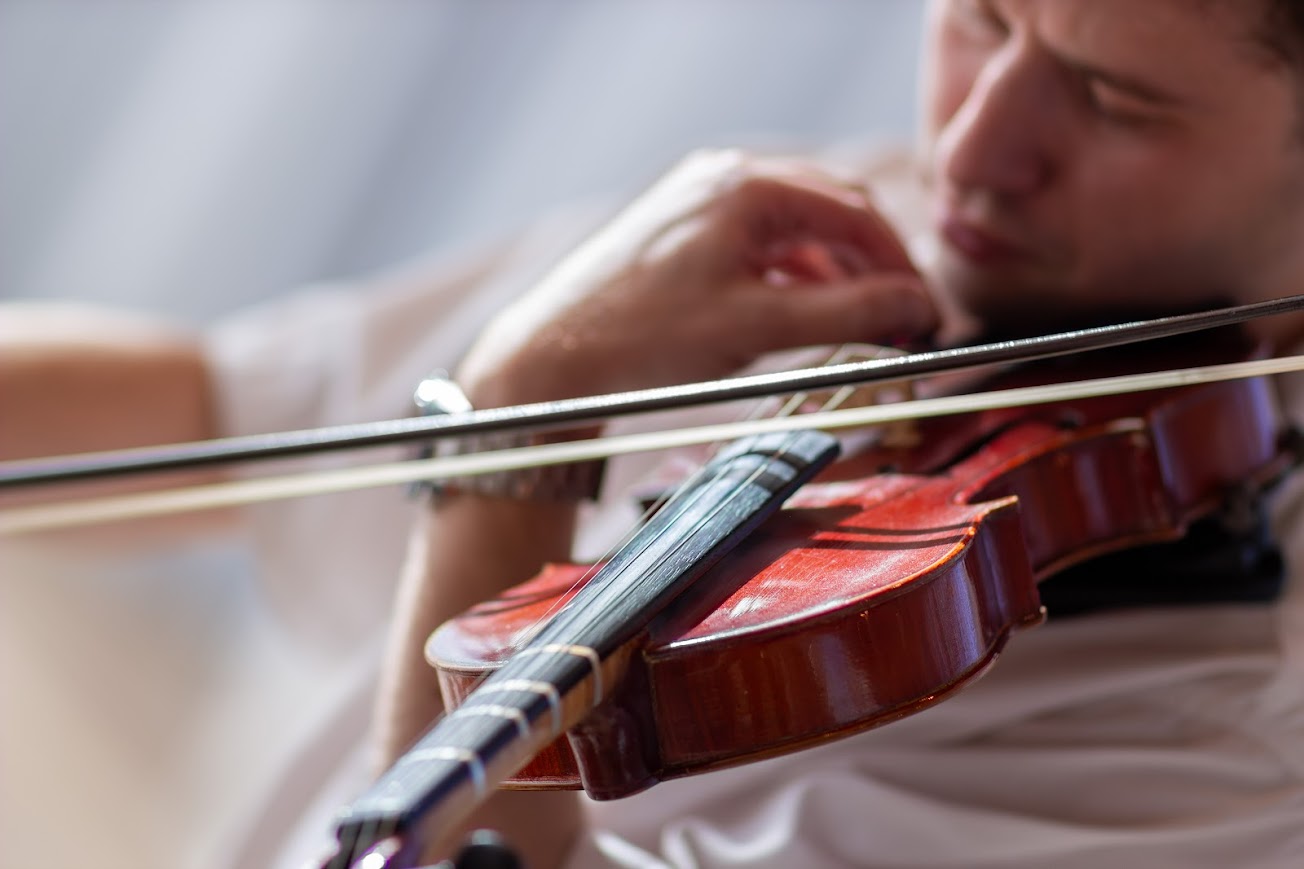Learning violin isn’t just about dragging a bow across four strings and hoping for something that doesn’t sound like a goose in distress. It’s about understanding where music actually lives on the instrument. On those strings, under your fingertips, and eventually, in your head.
For students, knowing their violin notes means freedom: you can play songs, improvise, and correct yourself when you’re out of tune.
For parents, it’s the difference between watching practice time turn into a meltdown and helping your kid finally play new songs with pride.
Let’s start where every violinist starts: the string notes.
Understanding the Notes in Violin Strings: G, D, A, and E Explained
The violin has four strings, tuned in perfect fifths. People ask: What are the 4 strings on a violin? From lowest to highest, they’re G, D, A, E.
Think of them like four starting points on a musical staircase.
Each string opens the door to a whole neighborhood of notes. You just move your fingers up to explore.
Mnemonic: Great Danes Always Eat: G, D, A, E.
.webp)
Kids remember it instantly, adults pretend it’s for the kids, but secretly need it too.
When you play an open string (no fingers), you get those pitches exactly. They’re also your tuning anchors; every other note you play is built from them.
Tuning Tip: Always start with A (the standard 440 Hz). Once that’s right, tune the rest by listening for that smooth, ringing harmony called a perfect fifth.
It should sound like both strings are vibrating together, not fighting each other.
If tuning still feels like defusing a bomb, that’s normal. Use an app or study our guide on how to tune violin strings.
Violin Notes Chart: Finding Notes on the Fingerboard
Here’s where things go from “pretty simple” to “wow, there’s a lot going on.”
Each string can play multiple notes depending on where you put your fingers.
Imagine your violin fingerboard as a street with invisible crosswalks. Each finger placement moves you up a half-step (that’s one note higher).
Four fingers give you roughly eight natural notes per string in first position — the comfort zone for every beginner.
Example: The G String
G (open) → G♯/A♭ (low 1) → A (1) → A♯/B♭ (low 2) → B (high 2) → C (3) → C♯/D♭ (high 3) → D (4).
The pattern repeats up each string:
- D string → D → E → F → G → A
- A string → A → B → C → D → E
- E string → E → F → G → A → B
Finger Positions and String Notes for Violin Beginners

Low fingers play the flats (closer to the scroll), high fingers play sharps (closer to the bridge). If your hand feels like it’s doing yoga, relax — everyone starts out hunting for those spots. Finger tapes help at first; they’re like training wheels.
Pro Tip for Parents: If your kid’s violin has little strips of colored tape on the fingerboard, that’s not decoration. That’s survival. Each tape marks where a note “lives.” After a few months, those tapes can come off, and muscle memory takes over.
Violin Strings Notes Chart: Every Note on the Fingerboard & Why Charts Work
A violin notes chart (or violin notes sheet) connects what your eyes see, ears hear, and fingers feel.
It’s not cheating; it’s scaffolding. Every builder needs one before they learn balance.

Learning these patterns trains your brain to recognize shapes rather than memorize letters. Eventually, you’ll see a note and your hand will just… go there. That’s the goal: effortless motion born from early chaos.
Learn more about violins in our article about violin parts: the bridge and the violin bow.
How to Read Violin Music Notes (Without Losing Your Mind)
If the violin fingerboard feels like a mystery, sheet music can look like an alien language at first. All lines, dots, and squiggles that seem to judge you silently. But once you crack the code, reading violin music notes becomes one of the most satisfying skills you’ll ever learn.
Reading and Playing the Notes on Violin Sheet Music
Here’s how it actually works.
1. The Staff: Where Music Lives
All violin music is written in the treble clef — the swirly “G” shape at the start of every line.
Think of it like the violin’s GPS system. It tells you where G sits on the staff, and every other note orbits around it.
- The lines spell out Every Good Boy Does Fine (E–G–B–D–F).
- The spaces spell FACE.
Boom. That’s your alphabet.

Once you know this, sheet music stops looking scary. It starts looking like… coordinates. Every dot has an address, and your fingers know where to go.
2. Note Names Meet Finger Numbers
Each written note links to a string and a finger number.
Beginners often see tiny numbers above notes in violin notes sheet music. That’s not decoration, it’s the instrument saying, “Hey, use this finger.” Soon enough, you won’t need those reminders, but at first, they’re gold.
3. Rhythm: The Part Everyone Skips (and Regrets Later)
Knowing which note to play is half the story; knowing how long to play it is the rest. This is rhythm: the heartbeat of music.
- Whole note = 4 beats (counts: 1,2,3,4)
- Half note = 2 beats (counts: 1,2)
- Quarter note = 1 beat (count: 1)
- Eighths = ½ beat
Play a song like Twinkle Twinkle using only open A and E strings, counting each beat out loud.
Yes, you’ll sound a little silly. That’s the point.
If you can count and bow in rhythm, you’re already doing better than 90 % of beginners who skip this step.
4. Connecting Sound, Sight & Feel
Reading notes isn’t just visual. It’s physical. You’ll start to feel where a C lives on your violin. You’ll recognize that C not just by its spot on the staff but by how your fingers stretch and how it feels under the bow.
Parents: this is the moment when things “click.” The student stops randomly guessing and starts reading. It’s one of those quiet, beautiful milestones that make all the squeaky practice hours worth it.
🎧 Practice Apps & Tools for Violin Students
🎯 Tips for Memorizing Notes & Practicing at Home
Learning notes on the violin is a muscle, not a test you cram for. You build it slowly, with repetition and fun.
Here’s how to make it stick.
1. Say the Notes Out Loud
Yes, really. Out loud.
Play a D scale and literally speak: “D… E… F♯… G… A…”
It wires your brain to link sound, letter, and feel. (Also, your neighbors will love it.)
2. Use Drones & Tuners
A drone is a long, steady note you play along with. Apps or YouTube have free drone tracks.
If you’re practicing the A string, play along with an A drone. You’ll start hearing when you’re sharp or flat.
A tuner app works too. Watch the needle hover in the center. That’s how you learn pitch accuracy without guessing.
3. Make Practice Bite-Sized
Five minutes on just one string’s notes is better than thirty minutes of frustrated guessing.
Pick a goal: “Today, I’ll master the notes on the D string.”
Celebrate small wins. They stack faster than you think.
4. Play Songs You Actually Like
If your child wants to play the Mario theme or a Taylor Swift melody, let them.
Learning happens faster when the song means something. Notes are notes, whether they belong to Mozart or Mario.
💡 Need a little extra guidance?
At Angeles Academy of Music, our violin teachers specialize in helping beginners master note reading and finger positions with confidence and fun.
🎻 Book a session today and see how structured practice turns into real progress, right here in Los Angeles.
Using Printable Violin Notes Charts and Apps
Technology is your friend, especially when practice gets messy.
Let’s talk about printable charts and apps that make your life easier (and keep practice from turning into World War III at home).
Printable Charts (Old-School & Powerful)
Print a violin notes chart that shows every note on every string. Tape it to the wall, the fridge, or the back of the violin case — anywhere you’ll actually see it.
Some versions even include both the fingerboard and the staff, so students connect dots (literally).
Color-coding helps younger kids: blue for open strings, green for first finger, and so on.
🎻 The Range of the Violin: What Comes Next
Right now, you’re mastering first position, the violin equivalent of learning your ABCs.
But here’s a peek at the future: the violin’s full range stretches roughly four octaves, from the low growl of G₃ up to the shimmering heights of A₇ (and sometimes higher if you like showing off).
Once your fingers feel comfortable, you’ll learn to shift, sliding your hand up the fingerboard into new “neighborhoods” of sound. It’s like climbing higher on the musical staircase you started on day one.
You don’t need to worry about that now. Just know that every great violinist once stood exactly where you are, trying to find an A on the D string and grinning when it finally sounded right.
❓ Frequently Asked Questions
Q: What’s a violin notes chart?
A: It’s a map of your violin’s fingerboard. It shows which notes live under which fingers on which string. Some call it a violin notes sheet when it also includes the notes on the staff. Think of it as Google Maps for your left hand.
Q: What’s the difference between violin string notes and violin music notes?
A: String notes = what you play. Music notes = what you read. Together, they turn squiggles on paper into real music.
Q: How can I help my child memorize notes?
A: Turn practice into games. Use flashcards, call-and-response drills (“Find me a B!”), or apps that reward correct answers. Bonus: Let them teach you a few notes. Kids remember faster when they get to play “teacher.”
Q: How do I tune a violin safely?
A: Start with the A string (440 Hz). Tune D, G, and E around it, using a tuner or app until each string hums in harmony. Tighten pegs slowly. Rushing breaks strings and hearts.
Q: What are violin music notes?
A: They’re the written notes you read on sheet music: the roadmap of every song. On the violin, they’re always in treble clef and use the letters A–G, sometimes with sharps or flats sprinkled in.
Q: How many notes does the violin have?
A: In first position, around 32 natural notes (8 per string). Across the whole instrument? Dozens more, spanning roughly four octaves. Enough to make a lifetime of music or drive your cat insane, depending on practice quality.
Q: Can I use alternate tunings?
A: Yes, but not yet. Advanced players use something called scordatura (re-tuning strings) for special effects or styles. Beginners: stick to standard tuning until your violin stops sounding like an argument between two birds.
Conclusion: The Sound of Progress
Here’s the truth no one tells beginners: every squeak is progress. Every time you hit the wrong note, your ear learns what “wrong” sounds like and how to fix it next time.
Mastering violin notes, on paper and on strings, is what unlocks real music. The more fluent you become, the less you think, and the more you just play.
That’s when the violin stops being an instrument and starts being a voice.
So print your charts, tune your strings, open your music, and get playing. Because one day, you’ll realize those random dots and squeaky sounds have turned into something extraordinary, a song you can actually call your own.
Ready to turn your practice into performance?
The journey from understanding violin notes to playing your favorite songs happens faster with the right teacher. At Angeles Academy of Music, our violin instructors blend expert technique with patient, motivating guidance.
Join our community of young musicians and families in Los Angeles. Your violin journey deserves the right start.
.svg)
.svg)
.svg)
.svg)
.svg)
.svg)

.webp)



.svg)